HRM503 Case Study: Applying Motivation Theories in Global HRM
VerifiedAdded on 2023/06/12
|17
|4019
|335
Case Study
AI Summary
This assignment provides a detailed analysis of motivation theories within the context of Human Resource Management (HRM), focusing on engaging and motivating employees. It begins by introducing the strategic importance of HRM and its role in achieving competitive objectives through effective workforce management. The report highlights various motivation theories, including Equity Theory, Hawthorne Effect, and Maslow's Need Hierarchy, discussing their influence on employee processes and behaviors. It further explores characteristics of a positive work environment, such as open communication, work-life balance, training, recognition, and strong team spirit. The assignment also examines job design strategies to motivate employees, referencing Hackman and Oldham's job characteristics model and the importance of meaningful work, responsibility, and knowledge of outcomes. Finally, it discusses the relationship between Maslow's components and job characteristics, concluding with the significance of motivation in enhancing employee satisfaction and productivity. This document contributed by a student is available on Desklib, a platform offering study tools and resources.
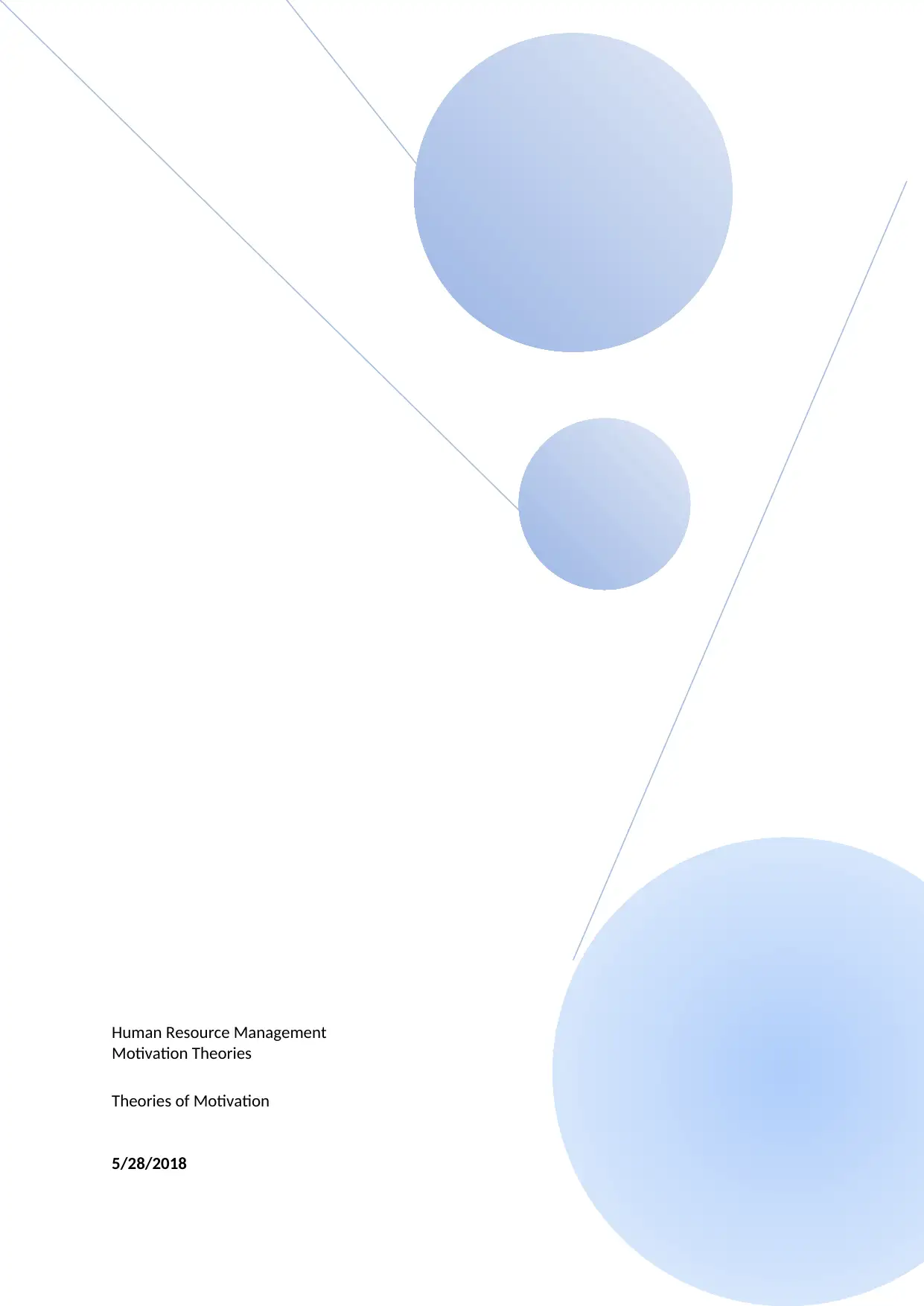
Human Resource Management
Motivation Theories
Theories of Motivation
5/28/2018
Motivation Theories
Theories of Motivation
5/28/2018
Paraphrase This Document
Need a fresh take? Get an instant paraphrase of this document with our AI Paraphraser
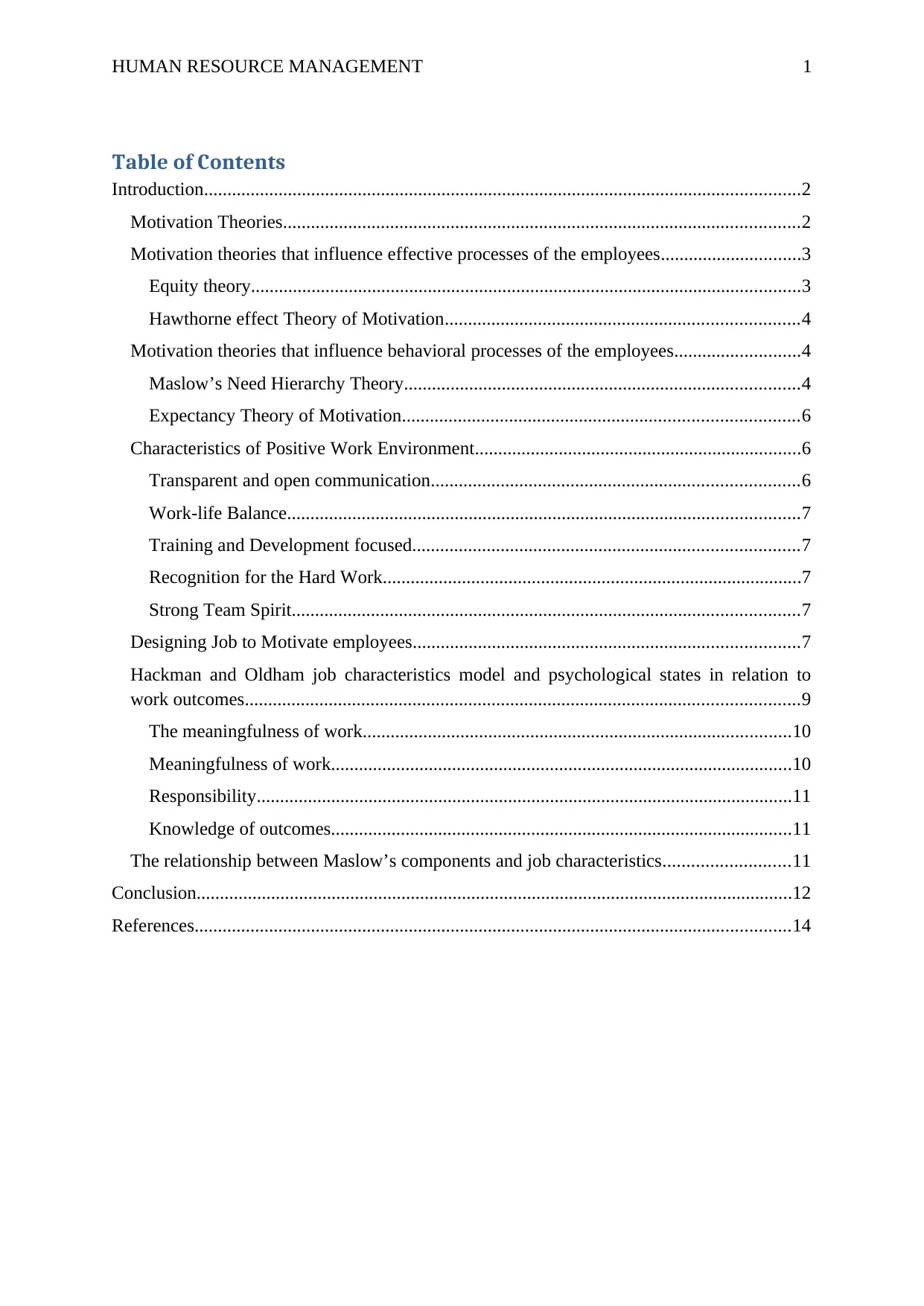
HUMAN RESOURCE MANAGEMENT 1
Table of Contents
Introduction................................................................................................................................2
Motivation Theories...............................................................................................................2
Motivation theories that influence effective processes of the employees..............................3
Equity theory......................................................................................................................3
Hawthorne effect Theory of Motivation............................................................................4
Motivation theories that influence behavioral processes of the employees...........................4
Maslow’s Need Hierarchy Theory.....................................................................................4
Expectancy Theory of Motivation.....................................................................................6
Characteristics of Positive Work Environment......................................................................6
Transparent and open communication...............................................................................6
Work-life Balance..............................................................................................................7
Training and Development focused...................................................................................7
Recognition for the Hard Work..........................................................................................7
Strong Team Spirit.............................................................................................................7
Designing Job to Motivate employees...................................................................................7
Hackman and Oldham job characteristics model and psychological states in relation to
work outcomes.......................................................................................................................9
The meaningfulness of work............................................................................................10
Meaningfulness of work...................................................................................................10
Responsibility...................................................................................................................11
Knowledge of outcomes...................................................................................................11
The relationship between Maslow’s components and job characteristics...........................11
Conclusion................................................................................................................................12
References................................................................................................................................14
Table of Contents
Introduction................................................................................................................................2
Motivation Theories...............................................................................................................2
Motivation theories that influence effective processes of the employees..............................3
Equity theory......................................................................................................................3
Hawthorne effect Theory of Motivation............................................................................4
Motivation theories that influence behavioral processes of the employees...........................4
Maslow’s Need Hierarchy Theory.....................................................................................4
Expectancy Theory of Motivation.....................................................................................6
Characteristics of Positive Work Environment......................................................................6
Transparent and open communication...............................................................................6
Work-life Balance..............................................................................................................7
Training and Development focused...................................................................................7
Recognition for the Hard Work..........................................................................................7
Strong Team Spirit.............................................................................................................7
Designing Job to Motivate employees...................................................................................7
Hackman and Oldham job characteristics model and psychological states in relation to
work outcomes.......................................................................................................................9
The meaningfulness of work............................................................................................10
Meaningfulness of work...................................................................................................10
Responsibility...................................................................................................................11
Knowledge of outcomes...................................................................................................11
The relationship between Maslow’s components and job characteristics...........................11
Conclusion................................................................................................................................12
References................................................................................................................................14
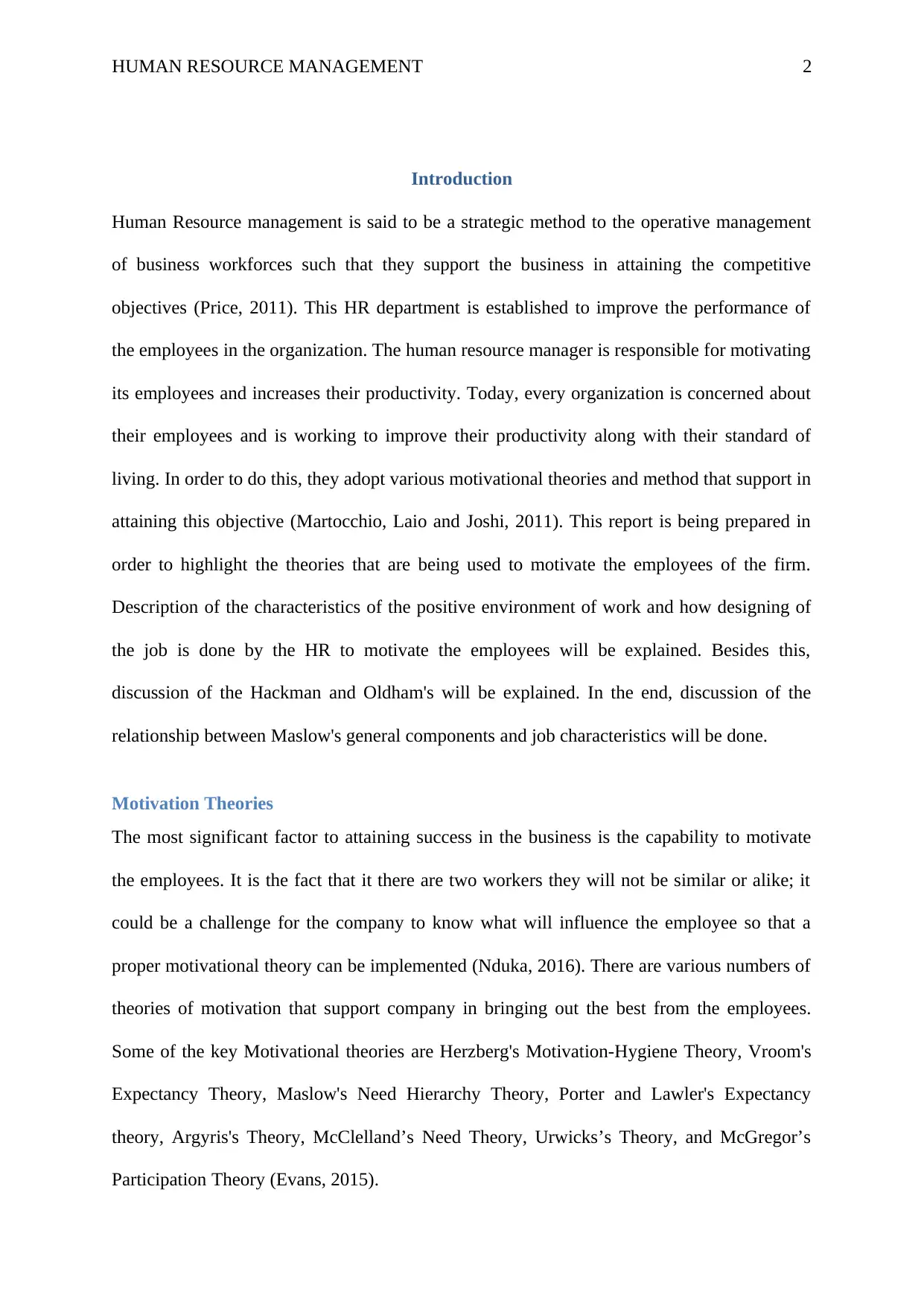
HUMAN RESOURCE MANAGEMENT 2
Introduction
Human Resource management is said to be a strategic method to the operative management
of business workforces such that they support the business in attaining the competitive
objectives (Price, 2011). This HR department is established to improve the performance of
the employees in the organization. The human resource manager is responsible for motivating
its employees and increases their productivity. Today, every organization is concerned about
their employees and is working to improve their productivity along with their standard of
living. In order to do this, they adopt various motivational theories and method that support in
attaining this objective (Martocchio, Laio and Joshi, 2011). This report is being prepared in
order to highlight the theories that are being used to motivate the employees of the firm.
Description of the characteristics of the positive environment of work and how designing of
the job is done by the HR to motivate the employees will be explained. Besides this,
discussion of the Hackman and Oldham's will be explained. In the end, discussion of the
relationship between Maslow's general components and job characteristics will be done.
Motivation Theories
The most significant factor to attaining success in the business is the capability to motivate
the employees. It is the fact that it there are two workers they will not be similar or alike; it
could be a challenge for the company to know what will influence the employee so that a
proper motivational theory can be implemented (Nduka, 2016). There are various numbers of
theories of motivation that support company in bringing out the best from the employees.
Some of the key Motivational theories are Herzberg's Motivation-Hygiene Theory, Vroom's
Expectancy Theory, Maslow's Need Hierarchy Theory, Porter and Lawler's Expectancy
theory, Argyris's Theory, McClelland’s Need Theory, Urwicks’s Theory, and McGregor’s
Participation Theory (Evans, 2015).
Introduction
Human Resource management is said to be a strategic method to the operative management
of business workforces such that they support the business in attaining the competitive
objectives (Price, 2011). This HR department is established to improve the performance of
the employees in the organization. The human resource manager is responsible for motivating
its employees and increases their productivity. Today, every organization is concerned about
their employees and is working to improve their productivity along with their standard of
living. In order to do this, they adopt various motivational theories and method that support in
attaining this objective (Martocchio, Laio and Joshi, 2011). This report is being prepared in
order to highlight the theories that are being used to motivate the employees of the firm.
Description of the characteristics of the positive environment of work and how designing of
the job is done by the HR to motivate the employees will be explained. Besides this,
discussion of the Hackman and Oldham's will be explained. In the end, discussion of the
relationship between Maslow's general components and job characteristics will be done.
Motivation Theories
The most significant factor to attaining success in the business is the capability to motivate
the employees. It is the fact that it there are two workers they will not be similar or alike; it
could be a challenge for the company to know what will influence the employee so that a
proper motivational theory can be implemented (Nduka, 2016). There are various numbers of
theories of motivation that support company in bringing out the best from the employees.
Some of the key Motivational theories are Herzberg's Motivation-Hygiene Theory, Vroom's
Expectancy Theory, Maslow's Need Hierarchy Theory, Porter and Lawler's Expectancy
theory, Argyris's Theory, McClelland’s Need Theory, Urwicks’s Theory, and McGregor’s
Participation Theory (Evans, 2015).
⊘ This is a preview!⊘
Do you want full access?
Subscribe today to unlock all pages.

Trusted by 1+ million students worldwide
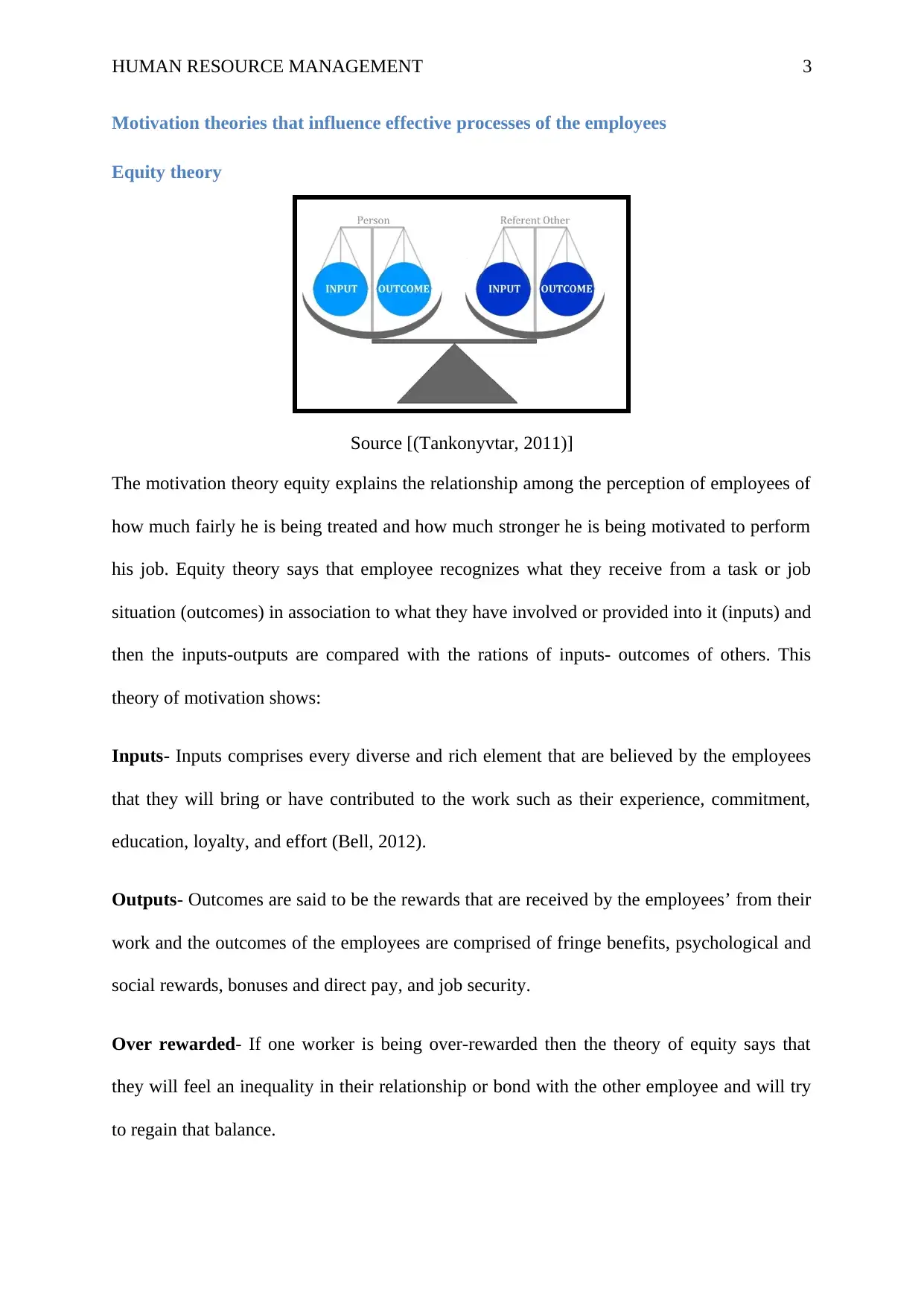
HUMAN RESOURCE MANAGEMENT 3
Motivation theories that influence effective processes of the employees
Equity theory
Source [(Tankonyvtar, 2011)]
The motivation theory equity explains the relationship among the perception of employees of
how much fairly he is being treated and how much stronger he is being motivated to perform
his job. Equity theory says that employee recognizes what they receive from a task or job
situation (outcomes) in association to what they have involved or provided into it (inputs) and
then the inputs-outputs are compared with the rations of inputs- outcomes of others. This
theory of motivation shows:
Inputs- Inputs comprises every diverse and rich element that are believed by the employees
that they will bring or have contributed to the work such as their experience, commitment,
education, loyalty, and effort (Bell, 2012).
Outputs- Outcomes are said to be the rewards that are received by the employees’ from their
work and the outcomes of the employees are comprised of fringe benefits, psychological and
social rewards, bonuses and direct pay, and job security.
Over rewarded- If one worker is being over-rewarded then the theory of equity says that
they will feel an inequality in their relationship or bond with the other employee and will try
to regain that balance.
Motivation theories that influence effective processes of the employees
Equity theory
Source [(Tankonyvtar, 2011)]
The motivation theory equity explains the relationship among the perception of employees of
how much fairly he is being treated and how much stronger he is being motivated to perform
his job. Equity theory says that employee recognizes what they receive from a task or job
situation (outcomes) in association to what they have involved or provided into it (inputs) and
then the inputs-outputs are compared with the rations of inputs- outcomes of others. This
theory of motivation shows:
Inputs- Inputs comprises every diverse and rich element that are believed by the employees
that they will bring or have contributed to the work such as their experience, commitment,
education, loyalty, and effort (Bell, 2012).
Outputs- Outcomes are said to be the rewards that are received by the employees’ from their
work and the outcomes of the employees are comprised of fringe benefits, psychological and
social rewards, bonuses and direct pay, and job security.
Over rewarded- If one worker is being over-rewarded then the theory of equity says that
they will feel an inequality in their relationship or bond with the other employee and will try
to regain that balance.
Paraphrase This Document
Need a fresh take? Get an instant paraphrase of this document with our AI Paraphraser
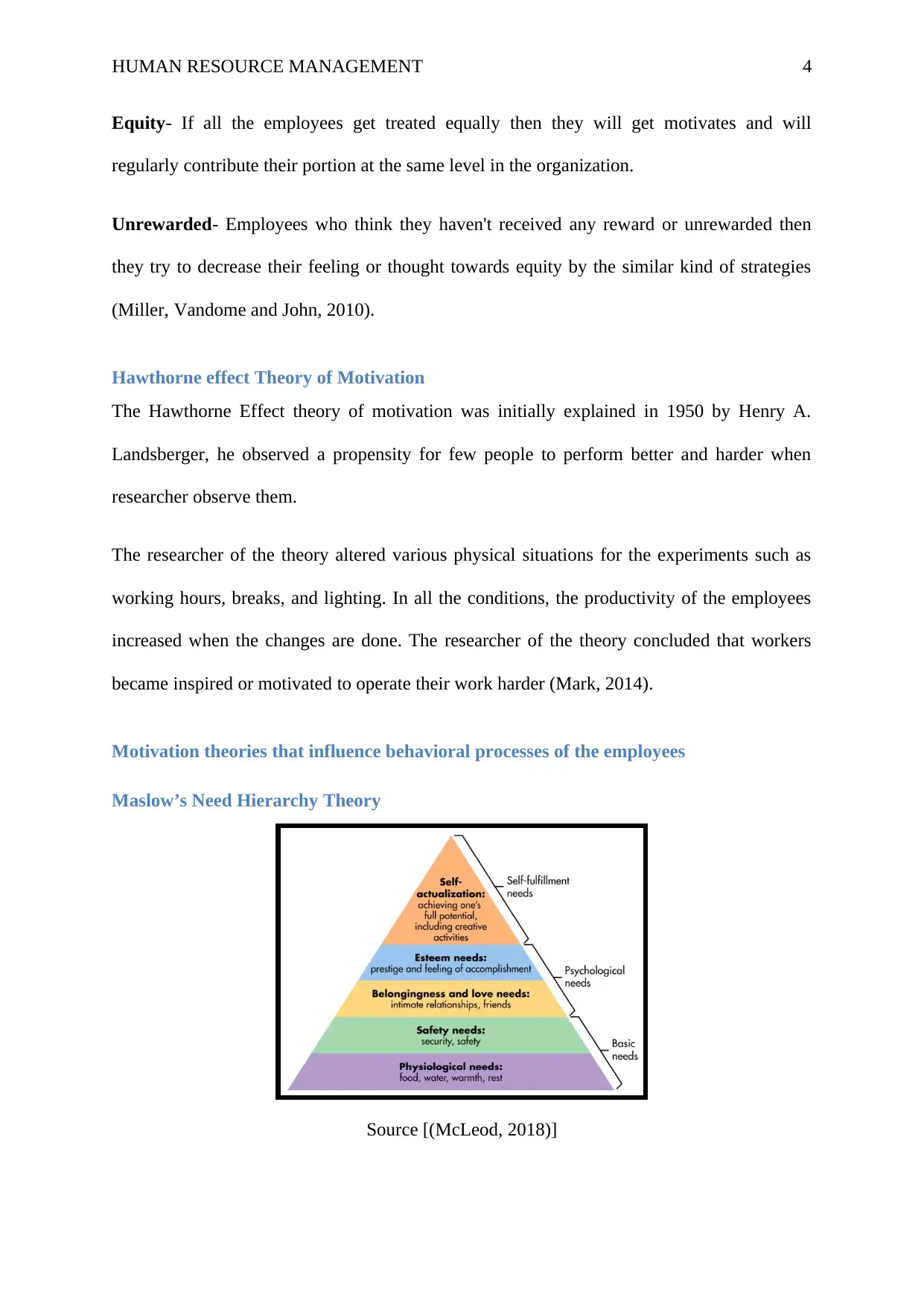
HUMAN RESOURCE MANAGEMENT 4
Equity- If all the employees get treated equally then they will get motivates and will
regularly contribute their portion at the same level in the organization.
Unrewarded- Employees who think they haven't received any reward or unrewarded then
they try to decrease their feeling or thought towards equity by the similar kind of strategies
(Miller, Vandome and John, 2010).
Hawthorne effect Theory of Motivation
The Hawthorne Effect theory of motivation was initially explained in 1950 by Henry A.
Landsberger, he observed a propensity for few people to perform better and harder when
researcher observe them.
The researcher of the theory altered various physical situations for the experiments such as
working hours, breaks, and lighting. In all the conditions, the productivity of the employees
increased when the changes are done. The researcher of the theory concluded that workers
became inspired or motivated to operate their work harder (Mark, 2014).
Motivation theories that influence behavioral processes of the employees
Maslow’s Need Hierarchy Theory
Source [(McLeod, 2018)]
Equity- If all the employees get treated equally then they will get motivates and will
regularly contribute their portion at the same level in the organization.
Unrewarded- Employees who think they haven't received any reward or unrewarded then
they try to decrease their feeling or thought towards equity by the similar kind of strategies
(Miller, Vandome and John, 2010).
Hawthorne effect Theory of Motivation
The Hawthorne Effect theory of motivation was initially explained in 1950 by Henry A.
Landsberger, he observed a propensity for few people to perform better and harder when
researcher observe them.
The researcher of the theory altered various physical situations for the experiments such as
working hours, breaks, and lighting. In all the conditions, the productivity of the employees
increased when the changes are done. The researcher of the theory concluded that workers
became inspired or motivated to operate their work harder (Mark, 2014).
Motivation theories that influence behavioral processes of the employees
Maslow’s Need Hierarchy Theory
Source [(McLeod, 2018)]
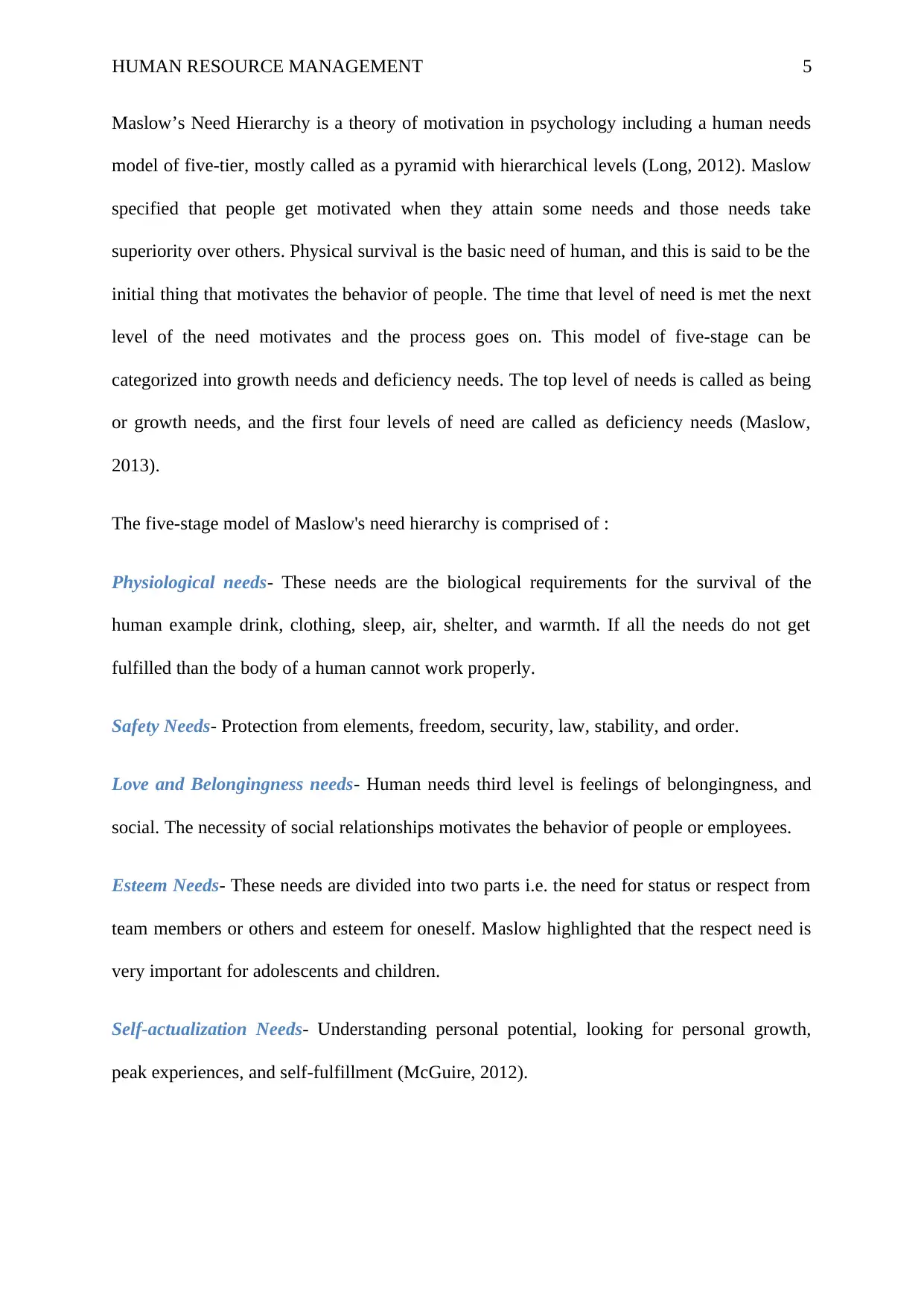
HUMAN RESOURCE MANAGEMENT 5
Maslow’s Need Hierarchy is a theory of motivation in psychology including a human needs
model of five-tier, mostly called as a pyramid with hierarchical levels (Long, 2012). Maslow
specified that people get motivated when they attain some needs and those needs take
superiority over others. Physical survival is the basic need of human, and this is said to be the
initial thing that motivates the behavior of people. The time that level of need is met the next
level of the need motivates and the process goes on. This model of five-stage can be
categorized into growth needs and deficiency needs. The top level of needs is called as being
or growth needs, and the first four levels of need are called as deficiency needs (Maslow,
2013).
The five-stage model of Maslow's need hierarchy is comprised of :
Physiological needs- These needs are the biological requirements for the survival of the
human example drink, clothing, sleep, air, shelter, and warmth. If all the needs do not get
fulfilled than the body of a human cannot work properly.
Safety Needs- Protection from elements, freedom, security, law, stability, and order.
Love and Belongingness needs- Human needs third level is feelings of belongingness, and
social. The necessity of social relationships motivates the behavior of people or employees.
Esteem Needs- These needs are divided into two parts i.e. the need for status or respect from
team members or others and esteem for oneself. Maslow highlighted that the respect need is
very important for adolescents and children.
Self-actualization Needs- Understanding personal potential, looking for personal growth,
peak experiences, and self-fulfillment (McGuire, 2012).
Maslow’s Need Hierarchy is a theory of motivation in psychology including a human needs
model of five-tier, mostly called as a pyramid with hierarchical levels (Long, 2012). Maslow
specified that people get motivated when they attain some needs and those needs take
superiority over others. Physical survival is the basic need of human, and this is said to be the
initial thing that motivates the behavior of people. The time that level of need is met the next
level of the need motivates and the process goes on. This model of five-stage can be
categorized into growth needs and deficiency needs. The top level of needs is called as being
or growth needs, and the first four levels of need are called as deficiency needs (Maslow,
2013).
The five-stage model of Maslow's need hierarchy is comprised of :
Physiological needs- These needs are the biological requirements for the survival of the
human example drink, clothing, sleep, air, shelter, and warmth. If all the needs do not get
fulfilled than the body of a human cannot work properly.
Safety Needs- Protection from elements, freedom, security, law, stability, and order.
Love and Belongingness needs- Human needs third level is feelings of belongingness, and
social. The necessity of social relationships motivates the behavior of people or employees.
Esteem Needs- These needs are divided into two parts i.e. the need for status or respect from
team members or others and esteem for oneself. Maslow highlighted that the respect need is
very important for adolescents and children.
Self-actualization Needs- Understanding personal potential, looking for personal growth,
peak experiences, and self-fulfillment (McGuire, 2012).
⊘ This is a preview!⊘
Do you want full access?
Subscribe today to unlock all pages.

Trusted by 1+ million students worldwide
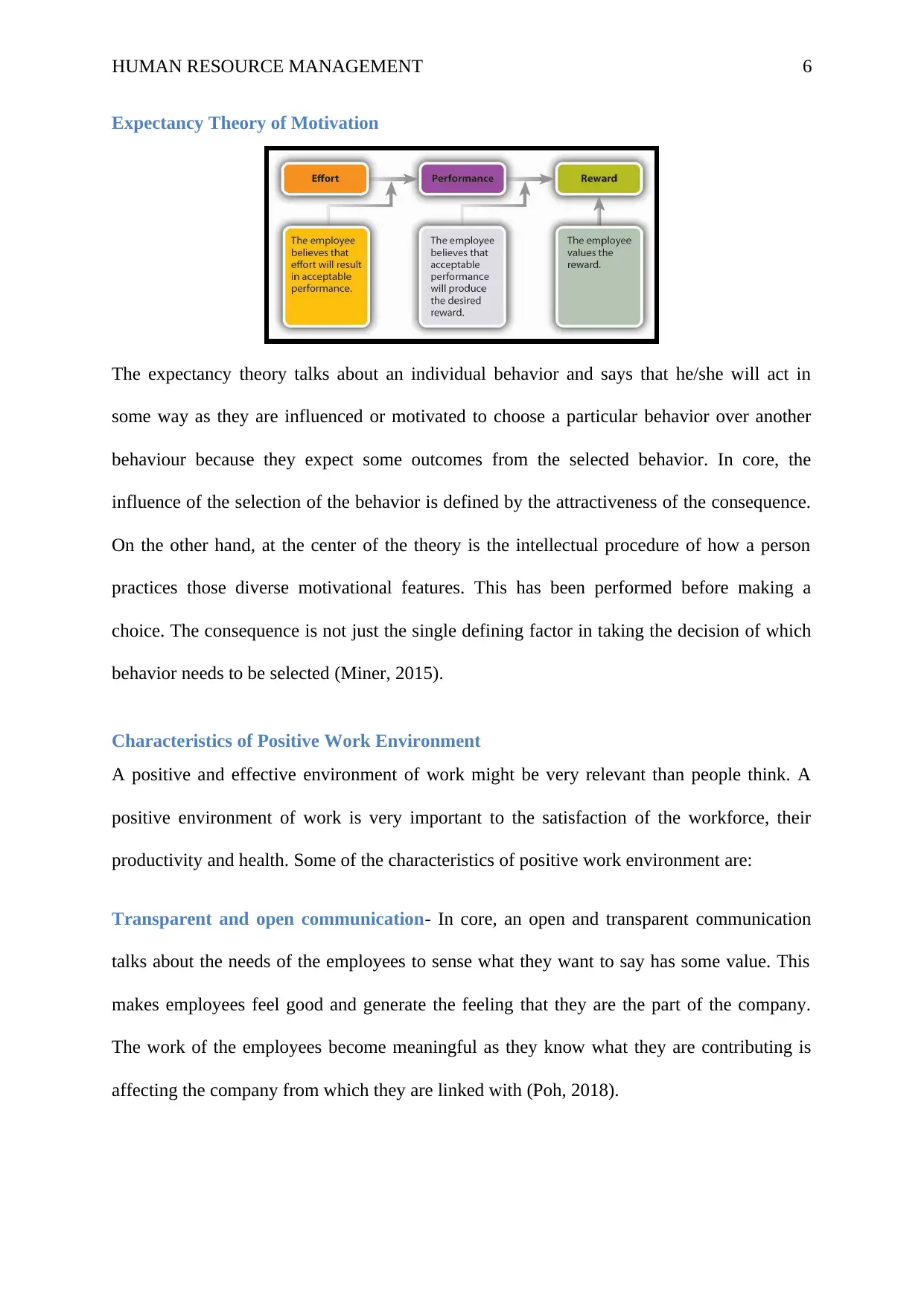
HUMAN RESOURCE MANAGEMENT 6
Expectancy Theory of Motivation
The expectancy theory talks about an individual behavior and says that he/she will act in
some way as they are influenced or motivated to choose a particular behavior over another
behaviour because they expect some outcomes from the selected behavior. In core, the
influence of the selection of the behavior is defined by the attractiveness of the consequence.
On the other hand, at the center of the theory is the intellectual procedure of how a person
practices those diverse motivational features. This has been performed before making a
choice. The consequence is not just the single defining factor in taking the decision of which
behavior needs to be selected (Miner, 2015).
Characteristics of Positive Work Environment
A positive and effective environment of work might be very relevant than people think. A
positive environment of work is very important to the satisfaction of the workforce, their
productivity and health. Some of the characteristics of positive work environment are:
Transparent and open communication- In core, an open and transparent communication
talks about the needs of the employees to sense what they want to say has some value. This
makes employees feel good and generate the feeling that they are the part of the company.
The work of the employees become meaningful as they know what they are contributing is
affecting the company from which they are linked with (Poh, 2018).
Expectancy Theory of Motivation
The expectancy theory talks about an individual behavior and says that he/she will act in
some way as they are influenced or motivated to choose a particular behavior over another
behaviour because they expect some outcomes from the selected behavior. In core, the
influence of the selection of the behavior is defined by the attractiveness of the consequence.
On the other hand, at the center of the theory is the intellectual procedure of how a person
practices those diverse motivational features. This has been performed before making a
choice. The consequence is not just the single defining factor in taking the decision of which
behavior needs to be selected (Miner, 2015).
Characteristics of Positive Work Environment
A positive and effective environment of work might be very relevant than people think. A
positive environment of work is very important to the satisfaction of the workforce, their
productivity and health. Some of the characteristics of positive work environment are:
Transparent and open communication- In core, an open and transparent communication
talks about the needs of the employees to sense what they want to say has some value. This
makes employees feel good and generate the feeling that they are the part of the company.
The work of the employees become meaningful as they know what they are contributing is
affecting the company from which they are linked with (Poh, 2018).
Paraphrase This Document
Need a fresh take? Get an instant paraphrase of this document with our AI Paraphraser
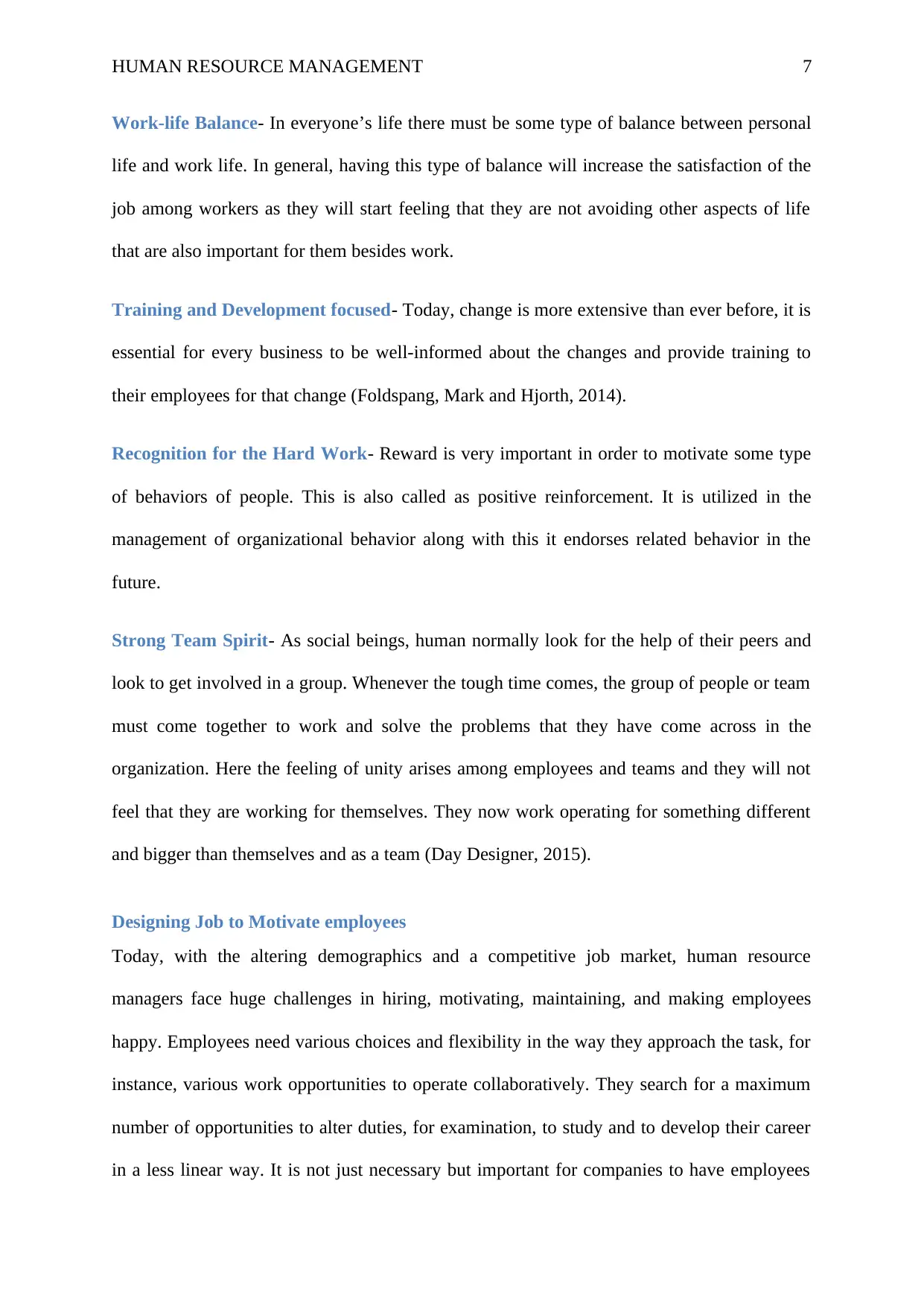
HUMAN RESOURCE MANAGEMENT 7
Work-life Balance- In everyone’s life there must be some type of balance between personal
life and work life. In general, having this type of balance will increase the satisfaction of the
job among workers as they will start feeling that they are not avoiding other aspects of life
that are also important for them besides work.
Training and Development focused- Today, change is more extensive than ever before, it is
essential for every business to be well-informed about the changes and provide training to
their employees for that change (Foldspang, Mark and Hjorth, 2014).
Recognition for the Hard Work- Reward is very important in order to motivate some type
of behaviors of people. This is also called as positive reinforcement. It is utilized in the
management of organizational behavior along with this it endorses related behavior in the
future.
Strong Team Spirit- As social beings, human normally look for the help of their peers and
look to get involved in a group. Whenever the tough time comes, the group of people or team
must come together to work and solve the problems that they have come across in the
organization. Here the feeling of unity arises among employees and teams and they will not
feel that they are working for themselves. They now work operating for something different
and bigger than themselves and as a team (Day Designer, 2015).
Designing Job to Motivate employees
Today, with the altering demographics and a competitive job market, human resource
managers face huge challenges in hiring, motivating, maintaining, and making employees
happy. Employees need various choices and flexibility in the way they approach the task, for
instance, various work opportunities to operate collaboratively. They search for a maximum
number of opportunities to alter duties, for examination, to study and to develop their career
in a less linear way. It is not just necessary but important for companies to have employees
Work-life Balance- In everyone’s life there must be some type of balance between personal
life and work life. In general, having this type of balance will increase the satisfaction of the
job among workers as they will start feeling that they are not avoiding other aspects of life
that are also important for them besides work.
Training and Development focused- Today, change is more extensive than ever before, it is
essential for every business to be well-informed about the changes and provide training to
their employees for that change (Foldspang, Mark and Hjorth, 2014).
Recognition for the Hard Work- Reward is very important in order to motivate some type
of behaviors of people. This is also called as positive reinforcement. It is utilized in the
management of organizational behavior along with this it endorses related behavior in the
future.
Strong Team Spirit- As social beings, human normally look for the help of their peers and
look to get involved in a group. Whenever the tough time comes, the group of people or team
must come together to work and solve the problems that they have come across in the
organization. Here the feeling of unity arises among employees and teams and they will not
feel that they are working for themselves. They now work operating for something different
and bigger than themselves and as a team (Day Designer, 2015).
Designing Job to Motivate employees
Today, with the altering demographics and a competitive job market, human resource
managers face huge challenges in hiring, motivating, maintaining, and making employees
happy. Employees need various choices and flexibility in the way they approach the task, for
instance, various work opportunities to operate collaboratively. They search for a maximum
number of opportunities to alter duties, for examination, to study and to develop their career
in a less linear way. It is not just necessary but important for companies to have employees
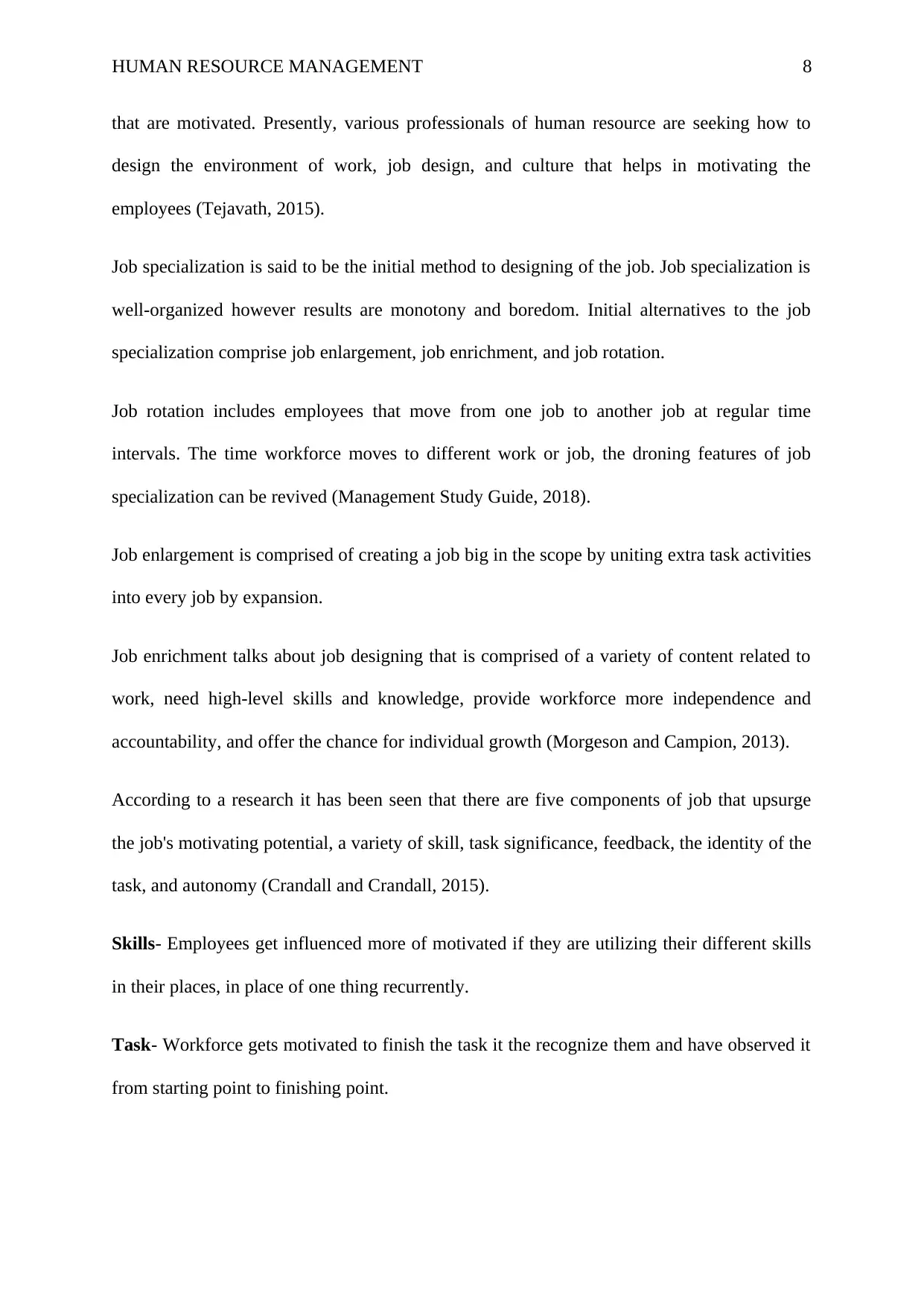
HUMAN RESOURCE MANAGEMENT 8
that are motivated. Presently, various professionals of human resource are seeking how to
design the environment of work, job design, and culture that helps in motivating the
employees (Tejavath, 2015).
Job specialization is said to be the initial method to designing of the job. Job specialization is
well-organized however results are monotony and boredom. Initial alternatives to the job
specialization comprise job enlargement, job enrichment, and job rotation.
Job rotation includes employees that move from one job to another job at regular time
intervals. The time workforce moves to different work or job, the droning features of job
specialization can be revived (Management Study Guide, 2018).
Job enlargement is comprised of creating a job big in the scope by uniting extra task activities
into every job by expansion.
Job enrichment talks about job designing that is comprised of a variety of content related to
work, need high-level skills and knowledge, provide workforce more independence and
accountability, and offer the chance for individual growth (Morgeson and Campion, 2013).
According to a research it has been seen that there are five components of job that upsurge
the job's motivating potential, a variety of skill, task significance, feedback, the identity of the
task, and autonomy (Crandall and Crandall, 2015).
Skills- Employees get influenced more of motivated if they are utilizing their different skills
in their places, in place of one thing recurrently.
Task- Workforce gets motivated to finish the task it the recognize them and have observed it
from starting point to finishing point.
that are motivated. Presently, various professionals of human resource are seeking how to
design the environment of work, job design, and culture that helps in motivating the
employees (Tejavath, 2015).
Job specialization is said to be the initial method to designing of the job. Job specialization is
well-organized however results are monotony and boredom. Initial alternatives to the job
specialization comprise job enlargement, job enrichment, and job rotation.
Job rotation includes employees that move from one job to another job at regular time
intervals. The time workforce moves to different work or job, the droning features of job
specialization can be revived (Management Study Guide, 2018).
Job enlargement is comprised of creating a job big in the scope by uniting extra task activities
into every job by expansion.
Job enrichment talks about job designing that is comprised of a variety of content related to
work, need high-level skills and knowledge, provide workforce more independence and
accountability, and offer the chance for individual growth (Morgeson and Campion, 2013).
According to a research it has been seen that there are five components of job that upsurge
the job's motivating potential, a variety of skill, task significance, feedback, the identity of the
task, and autonomy (Crandall and Crandall, 2015).
Skills- Employees get influenced more of motivated if they are utilizing their different skills
in their places, in place of one thing recurrently.
Task- Workforce gets motivated to finish the task it the recognize them and have observed it
from starting point to finishing point.
⊘ This is a preview!⊘
Do you want full access?
Subscribe today to unlock all pages.

Trusted by 1+ million students worldwide
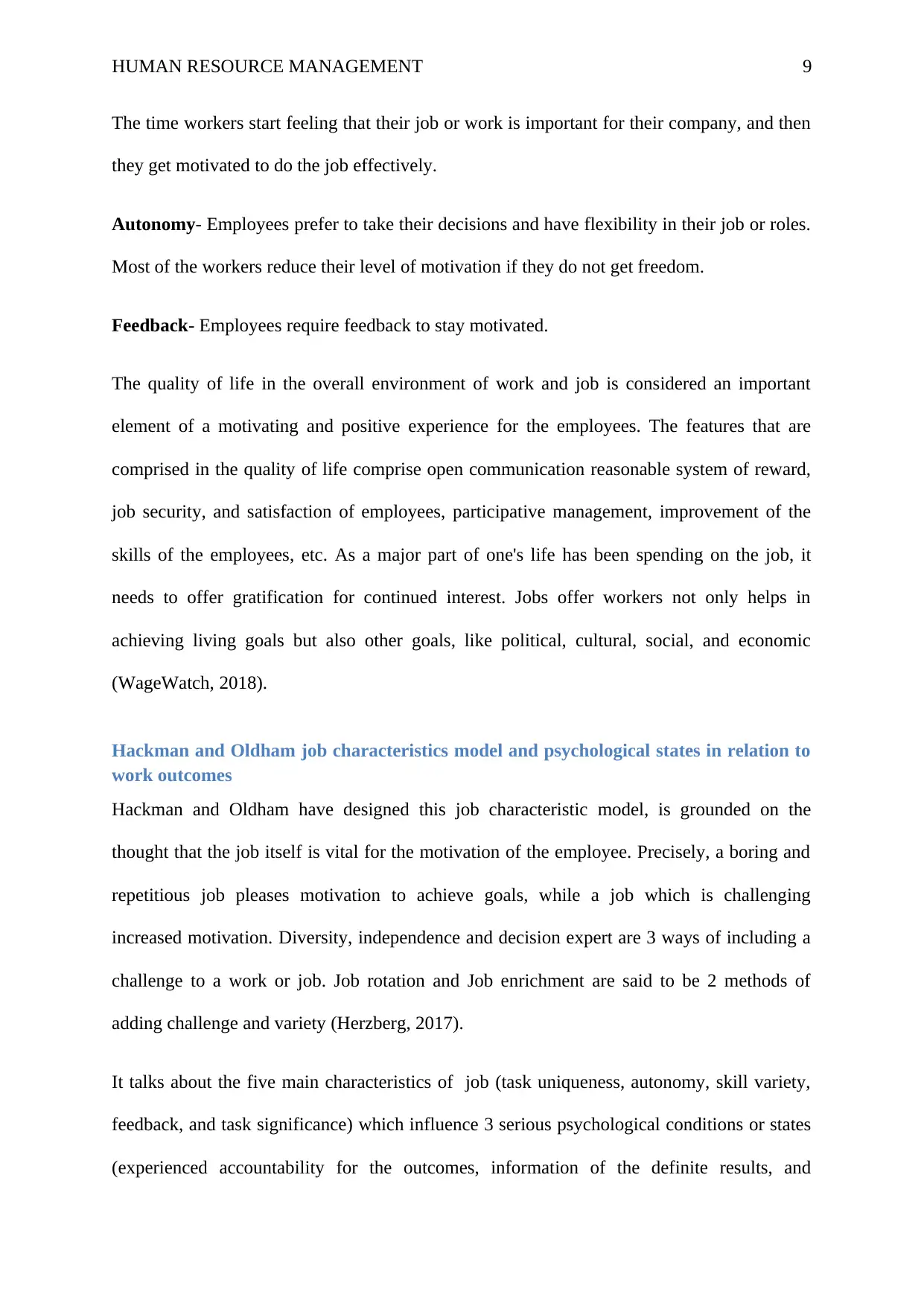
HUMAN RESOURCE MANAGEMENT 9
The time workers start feeling that their job or work is important for their company, and then
they get motivated to do the job effectively.
Autonomy- Employees prefer to take their decisions and have flexibility in their job or roles.
Most of the workers reduce their level of motivation if they do not get freedom.
Feedback- Employees require feedback to stay motivated.
The quality of life in the overall environment of work and job is considered an important
element of a motivating and positive experience for the employees. The features that are
comprised in the quality of life comprise open communication reasonable system of reward,
job security, and satisfaction of employees, participative management, improvement of the
skills of the employees, etc. As a major part of one's life has been spending on the job, it
needs to offer gratification for continued interest. Jobs offer workers not only helps in
achieving living goals but also other goals, like political, cultural, social, and economic
(WageWatch, 2018).
Hackman and Oldham job characteristics model and psychological states in relation to
work outcomes
Hackman and Oldham have designed this job characteristic model, is grounded on the
thought that the job itself is vital for the motivation of the employee. Precisely, a boring and
repetitious job pleases motivation to achieve goals, while a job which is challenging
increased motivation. Diversity, independence and decision expert are 3 ways of including a
challenge to a work or job. Job rotation and Job enrichment are said to be 2 methods of
adding challenge and variety (Herzberg, 2017).
It talks about the five main characteristics of job (task uniqueness, autonomy, skill variety,
feedback, and task significance) which influence 3 serious psychological conditions or states
(experienced accountability for the outcomes, information of the definite results, and
The time workers start feeling that their job or work is important for their company, and then
they get motivated to do the job effectively.
Autonomy- Employees prefer to take their decisions and have flexibility in their job or roles.
Most of the workers reduce their level of motivation if they do not get freedom.
Feedback- Employees require feedback to stay motivated.
The quality of life in the overall environment of work and job is considered an important
element of a motivating and positive experience for the employees. The features that are
comprised in the quality of life comprise open communication reasonable system of reward,
job security, and satisfaction of employees, participative management, improvement of the
skills of the employees, etc. As a major part of one's life has been spending on the job, it
needs to offer gratification for continued interest. Jobs offer workers not only helps in
achieving living goals but also other goals, like political, cultural, social, and economic
(WageWatch, 2018).
Hackman and Oldham job characteristics model and psychological states in relation to
work outcomes
Hackman and Oldham have designed this job characteristic model, is grounded on the
thought that the job itself is vital for the motivation of the employee. Precisely, a boring and
repetitious job pleases motivation to achieve goals, while a job which is challenging
increased motivation. Diversity, independence and decision expert are 3 ways of including a
challenge to a work or job. Job rotation and Job enrichment are said to be 2 methods of
adding challenge and variety (Herzberg, 2017).
It talks about the five main characteristics of job (task uniqueness, autonomy, skill variety,
feedback, and task significance) which influence 3 serious psychological conditions or states
(experienced accountability for the outcomes, information of the definite results, and
Paraphrase This Document
Need a fresh take? Get an instant paraphrase of this document with our AI Paraphraser
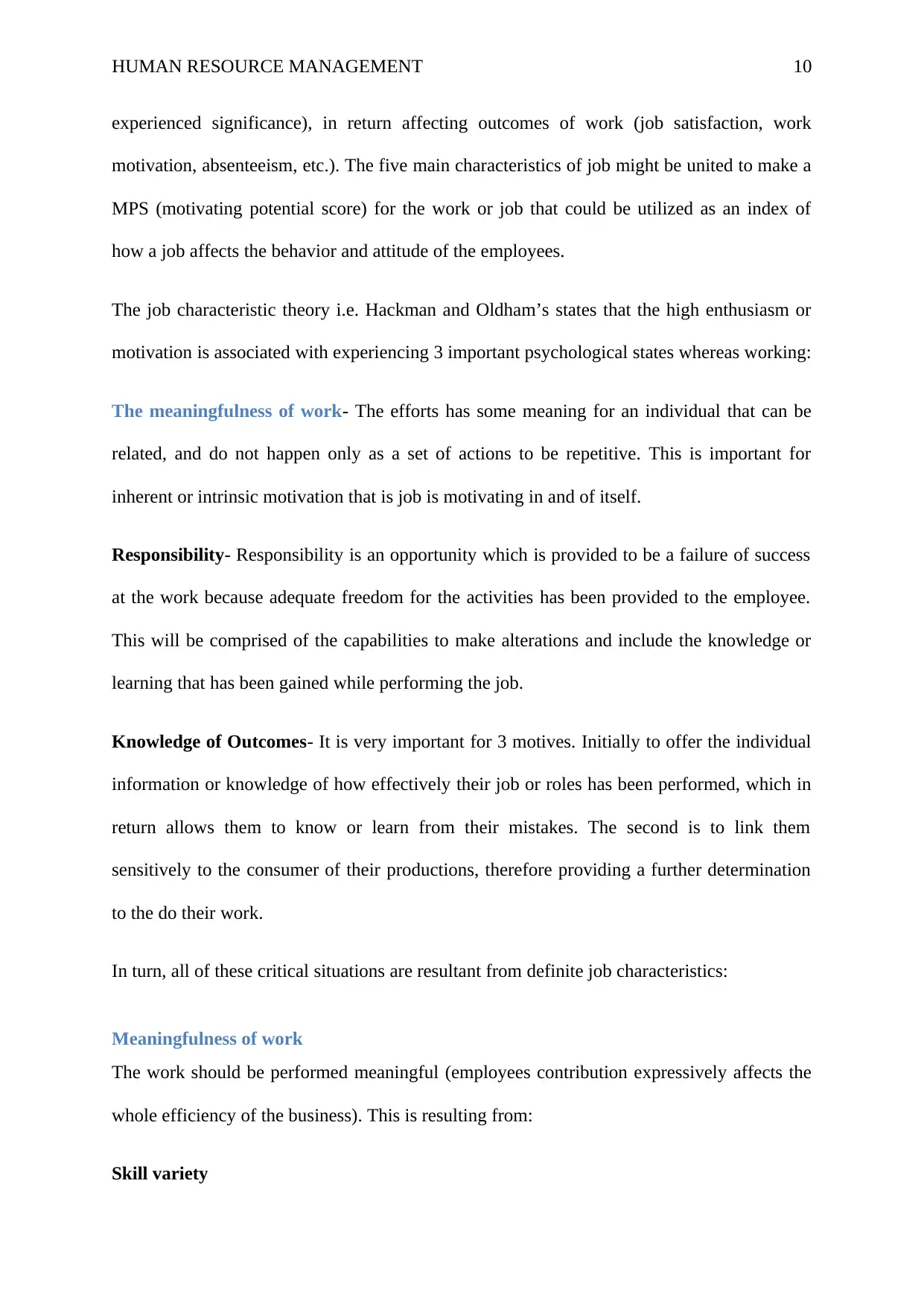
HUMAN RESOURCE MANAGEMENT 10
experienced significance), in return affecting outcomes of work (job satisfaction, work
motivation, absenteeism, etc.). The five main characteristics of job might be united to make a
MPS (motivating potential score) for the work or job that could be utilized as an index of
how a job affects the behavior and attitude of the employees.
The job characteristic theory i.e. Hackman and Oldham’s states that the high enthusiasm or
motivation is associated with experiencing 3 important psychological states whereas working:
The meaningfulness of work- The efforts has some meaning for an individual that can be
related, and do not happen only as a set of actions to be repetitive. This is important for
inherent or intrinsic motivation that is job is motivating in and of itself.
Responsibility- Responsibility is an opportunity which is provided to be a failure of success
at the work because adequate freedom for the activities has been provided to the employee.
This will be comprised of the capabilities to make alterations and include the knowledge or
learning that has been gained while performing the job.
Knowledge of Outcomes- It is very important for 3 motives. Initially to offer the individual
information or knowledge of how effectively their job or roles has been performed, which in
return allows them to know or learn from their mistakes. The second is to link them
sensitively to the consumer of their productions, therefore providing a further determination
to the do their work.
In turn, all of these critical situations are resultant from definite job characteristics:
Meaningfulness of work
The work should be performed meaningful (employees contribution expressively affects the
whole efficiency of the business). This is resulting from:
Skill variety
experienced significance), in return affecting outcomes of work (job satisfaction, work
motivation, absenteeism, etc.). The five main characteristics of job might be united to make a
MPS (motivating potential score) for the work or job that could be utilized as an index of
how a job affects the behavior and attitude of the employees.
The job characteristic theory i.e. Hackman and Oldham’s states that the high enthusiasm or
motivation is associated with experiencing 3 important psychological states whereas working:
The meaningfulness of work- The efforts has some meaning for an individual that can be
related, and do not happen only as a set of actions to be repetitive. This is important for
inherent or intrinsic motivation that is job is motivating in and of itself.
Responsibility- Responsibility is an opportunity which is provided to be a failure of success
at the work because adequate freedom for the activities has been provided to the employee.
This will be comprised of the capabilities to make alterations and include the knowledge or
learning that has been gained while performing the job.
Knowledge of Outcomes- It is very important for 3 motives. Initially to offer the individual
information or knowledge of how effectively their job or roles has been performed, which in
return allows them to know or learn from their mistakes. The second is to link them
sensitively to the consumer of their productions, therefore providing a further determination
to the do their work.
In turn, all of these critical situations are resultant from definite job characteristics:
Meaningfulness of work
The work should be performed meaningful (employees contribution expressively affects the
whole efficiency of the business). This is resulting from:
Skill variety
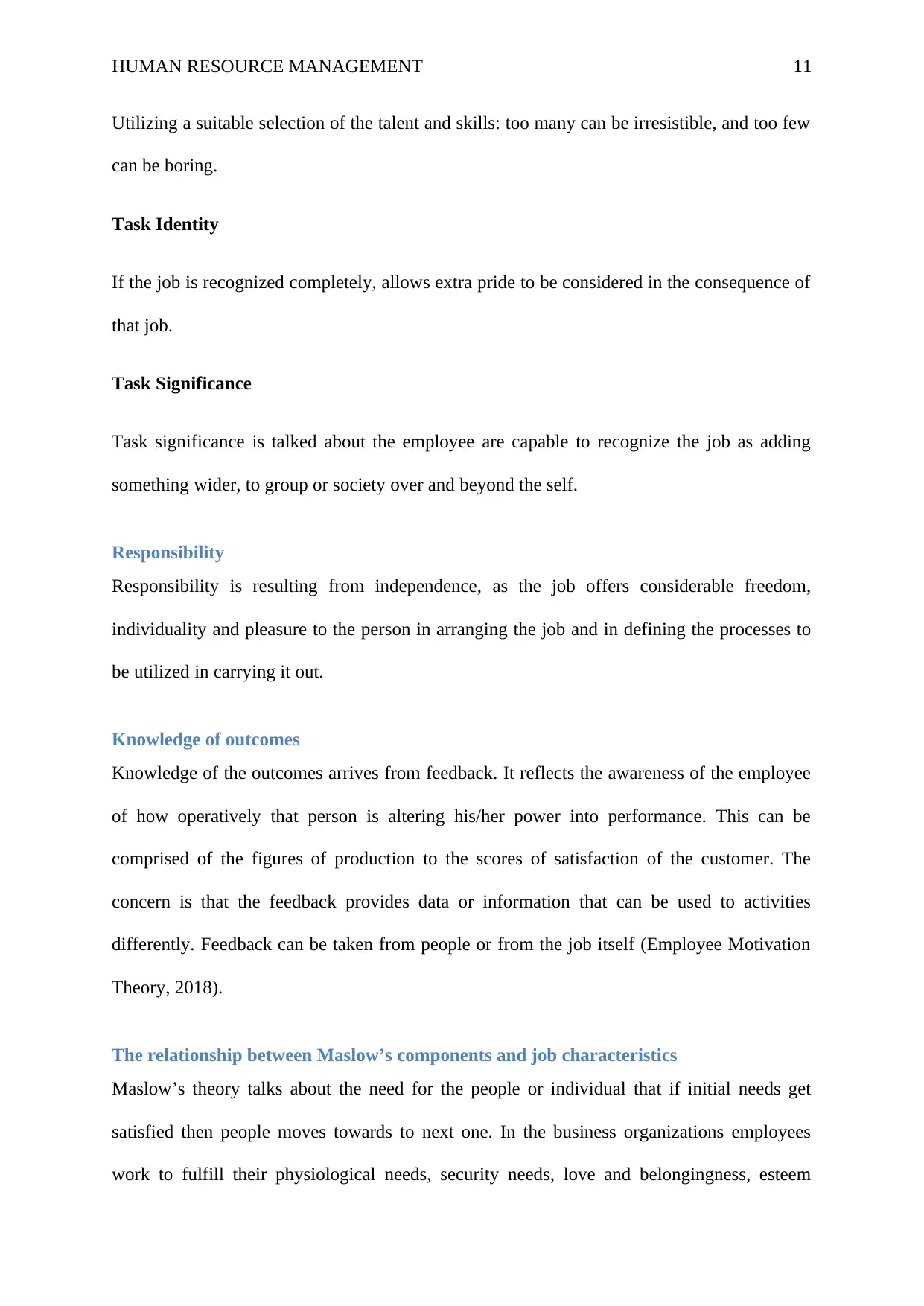
HUMAN RESOURCE MANAGEMENT 11
Utilizing a suitable selection of the talent and skills: too many can be irresistible, and too few
can be boring.
Task Identity
If the job is recognized completely, allows extra pride to be considered in the consequence of
that job.
Task Significance
Task significance is talked about the employee are capable to recognize the job as adding
something wider, to group or society over and beyond the self.
Responsibility
Responsibility is resulting from independence, as the job offers considerable freedom,
individuality and pleasure to the person in arranging the job and in defining the processes to
be utilized in carrying it out.
Knowledge of outcomes
Knowledge of the outcomes arrives from feedback. It reflects the awareness of the employee
of how operatively that person is altering his/her power into performance. This can be
comprised of the figures of production to the scores of satisfaction of the customer. The
concern is that the feedback provides data or information that can be used to activities
differently. Feedback can be taken from people or from the job itself (Employee Motivation
Theory, 2018).
The relationship between Maslow’s components and job characteristics
Maslow’s theory talks about the need for the people or individual that if initial needs get
satisfied then people moves towards to next one. In the business organizations employees
work to fulfill their physiological needs, security needs, love and belongingness, esteem
Utilizing a suitable selection of the talent and skills: too many can be irresistible, and too few
can be boring.
Task Identity
If the job is recognized completely, allows extra pride to be considered in the consequence of
that job.
Task Significance
Task significance is talked about the employee are capable to recognize the job as adding
something wider, to group or society over and beyond the self.
Responsibility
Responsibility is resulting from independence, as the job offers considerable freedom,
individuality and pleasure to the person in arranging the job and in defining the processes to
be utilized in carrying it out.
Knowledge of outcomes
Knowledge of the outcomes arrives from feedback. It reflects the awareness of the employee
of how operatively that person is altering his/her power into performance. This can be
comprised of the figures of production to the scores of satisfaction of the customer. The
concern is that the feedback provides data or information that can be used to activities
differently. Feedback can be taken from people or from the job itself (Employee Motivation
Theory, 2018).
The relationship between Maslow’s components and job characteristics
Maslow’s theory talks about the need for the people or individual that if initial needs get
satisfied then people moves towards to next one. In the business organizations employees
work to fulfill their physiological needs, security needs, love and belongingness, esteem
⊘ This is a preview!⊘
Do you want full access?
Subscribe today to unlock all pages.

Trusted by 1+ million students worldwide
1 out of 17
Related Documents
Your All-in-One AI-Powered Toolkit for Academic Success.
+13062052269
info@desklib.com
Available 24*7 on WhatsApp / Email
![[object Object]](/_next/static/media/star-bottom.7253800d.svg)
Unlock your academic potential
Copyright © 2020–2025 A2Z Services. All Rights Reserved. Developed and managed by ZUCOL.




